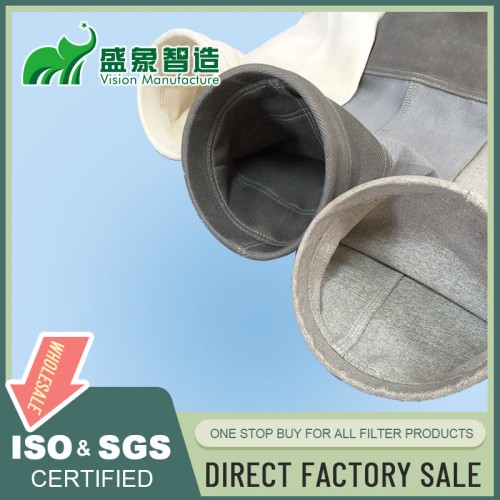
Fiberglass Dust Collection Bags Excel in High-Temperature Applications
I. Introduction
High-temperature dust collection presents unique challenges in industrial environments, necessitating materials that can withstand extreme conditions without degrading. Fiberglass, known for its robustness in high-temperature applications, is a critical material in dust collection systems, playing a pivotal role in maintaining operational efficiency and ensuring compliance with environmental standards.
II. Properties of Fiberglass Dust Collection Bags
Fiberglass dust collection bags are favored for their exceptional properties:
- Heat Resistance Characteristics: Can operate continuously at temperatures up to 260°C and handle surges up to 280°C.
- Chemical Inertness: Exhibits excellent resistance to a wide range of chemicals, making it suitable for various industrial applications.
- Tensile Strength and Durability: Offers high breaking strength, ensuring durability under stress.
- Filtration Efficiency: Maintains effective particle capture even under demanding conditions.
III. Types of Fiberglass Dust Collection Bags
Various designs cater to specific industrial needs and system requirements:
- Woven Fiberglass Bags: Common designs used in many industries for general applications.
- Needle-felt Fiberglass Bags: Provide enhanced filtration efficiency and durability.
- PTFE-laminated Fiberglass Bags: Offer superior chemical and heat resistance.
- Specialty Coated Fiberglass Bags: Include coatings for additional protection and performance enhancement.
IV. High-Temperature Performance
Fiberglass bags are designed to perform optimally in high-temperature settings:
- Maximum Operating Temperatures: Capable of sustained performance at elevated temperatures without degradation.
- Thermal Stability Over Time: Maintains structural integrity and efficiency despite prolonged exposure to high temperatures.
- Comparison with Other High-Temp Materials: Often outperforms alternative materials in terms of thermal stability and efficiency.
- Impact on Filtration Efficiency: Ensures consistent particle removal efficiency, crucial for maintaining air quality and system performance.
V. Industrial Applications
Fiberglass filter bags are essential in industries where high temperatures are prevalent:
- Cement and Lime Production: Essential for handling high-temperature gases and residues.
- Steel and Metal Processing: Filters metal particulates, preventing them from entering the air.
- Power Generation Plants: Used in coal-fired utilities to manage fly ash.
- Waste Incineration Facilities: Helps manage emissions and capture byproducts.
- Chemical and Petrochemical Industries: Provides reliable filtration amidst corrosive substances.
- Glass Manufacturing: Critical for maintaining purity and quality in production.
VI. Design and Construction
The design and construction of fiberglass bags are tailored to meet the rigorous demands of extreme environments:
- Fiber Composition and Treatment: Typically involves a blend of fiberglass and other synthetic materials to enhance performance.
- Weave Patterns and Densities: Optimized to provide the best balance between airflow and particle capture.
- Bag Shapes and Sizes: Available in various dimensions to accommodate different systems.
- Finishing Treatments and Coatings: Often includes treatments like singeing or coating to improve durability and performance.
VII. Operational Benefits
Using fiberglass filters in high-temperature environments offers several advantages:
- Extended Service Life in Extreme Conditions: Reduces the frequency of replacements.
- Consistent Performance at High Temperatures: Maintains filtration effectiveness throughout its service life.
- Reduced Maintenance Frequency: Lowers operational costs and downtime.
- Improved Emissions Control: Effective in capturing fine particulates, aiding in compliance with environmental regulations.
VIII. Installation Considerations
Proper installation is crucial for the optimal performance of fiberglass bags:
- Proper Handling Techniques: Ensures the integrity of the filters during setup.
- Cage and Venturi System Compatibility: Checks compatibility to prevent installation issues.
- Precoating Procedures: Sometimes necessary to enhance initial filtration efficiency.
- Break-in Period Management: Important for stabilizing the filter's performance after installation.
IX. Maintenance and Longevity
Maintaining fiberglass bags involves:
- Inspection Schedules and Methods: Regular checks to ensure optimal performance.
- Cleaning Techniques: Includes methods like pulse-jet, reverse air, and shaker systems.
- Replacement Indicators: Knowing when to replace filters to maintain system efficiency.
- Proper Disposal Practices: Ensures environmentally responsible handling of used filters.
X. Regulatory Compliance
Fiberglass bag filters help facilities meet stringent regulatory requirements:
- Emission Standards for Various Industries: Adherence to federal and state environmental guidelines.
- Workplace Safety Regulations: Ensuring worker safety in handling and operations.
- Local and State Air Quality Requirements: Compliance with local regulations regarding air quality.
- Industry-specific Guidelines: Meeting standards specific to the fiberglass industry.
XI. Cost-Benefit Analysis
Evaluating the cost-effectiveness of fiberglass filters involves:
- Initial Investment Considerations: Upfront costs of system installation.
- Operational Costs: Ongoing expenses related to energy use and maintenance.
- Maintenance and Replacement Expenses: Costs associated with regular upkeep and part replacement.
- ROI Analysis and Payback Period: Assessing the financial return on investment over time.
XII. Environmental Benefits
Fiberglass filters contribute to environmental sustainability in several ways:
- Reduced Airborne Particulate Emissions: Lower emissions contribute to cleaner air.
- Improved Workplace Air Quality: Enhances the health and safety environment for workers.
- Energy Efficiency Contributions: Reduces the energy demand of dust collection systems.
- Material Conservation Through Reclamation: Facilitates the recovery of materials from collected dust.
XIII. Case Studies
Illustrative examples from various industries demonstrate the effectiveness of fiberglass bag filters in solving complex filtration challenges and enhancing system performance, showcasing significant improvements in operational efficiency and compliance with environmental standards.
XIV. Technological Advancements
Future developments in fiberglass filter technology include:
- Advanced Filter Media and Designs: Enhancements that improve durability and filtration efficiency.
- Smart Monitoring and Predictive Maintenance Systems: Incorporation of sensors and monitoring systems for better management.
- Energy-efficient Fan and Motor Technologies: Innovations that reduce maintenance demands.
- Integration with Plant-wide Digital Systems: Streamlining operations across facilities.
XV. Conclusion
Fiberglass dust collection bags are essential components in modern industrial filtration systems, offering significant benefits in terms of efficiency, cost-effectiveness, and environmental compliance. As technology advances, these systems are expected to become even more integral to industrial operations, emphasizing the importance of continuous improvement and adoption of the latest innovations.
Leave a comment

